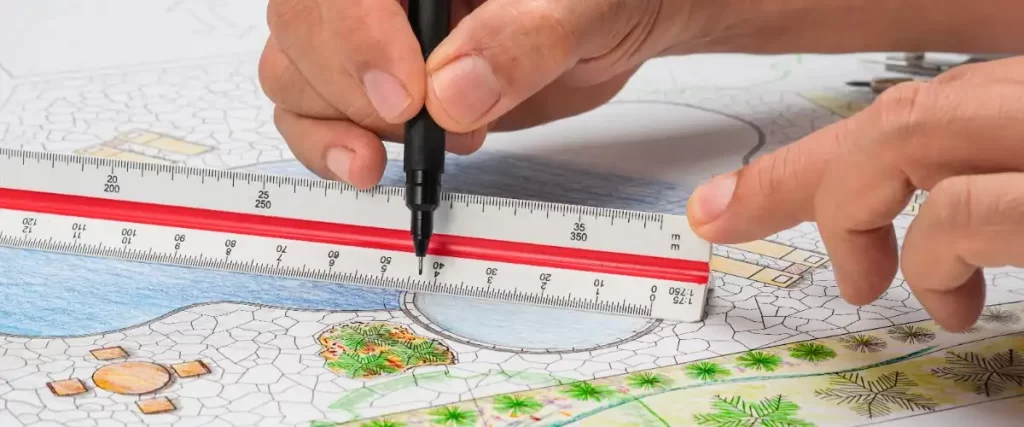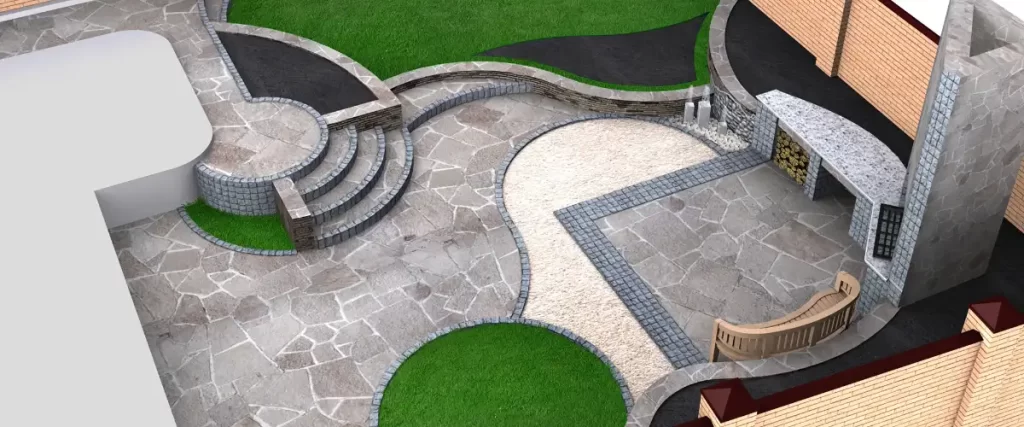Homeowners often wonder who they should hire for an outdoor project. Both landscape architects and landscape designers shape outdoor spaces, create plans, and guide clients toward a finished landscape.
They simply approach the work from different angles. If you understand the differences early, choosing the right professional becomes much easier.
To help you skim quickly, here is a simple comparison.

Landscape Architect vs Landscape Designer: A Quick Comparison
| Category | Landscape Architect | Landscape Designer |
|---|---|---|
| Meaning of the title | A design professional trained in landscape architecture who can legally use the title only after completing specific education and licensing steps. | A design professional who creates outdoor plans, usually plant-focused or residential in scale. The title is not legally restricted. |
| Education required | Bachelor's or master's degree in landscape architecture from a university-accredited program. | Varies widely. May include an associate's degree, certificate, or self-directed learning with hands-on experience. |
| Licensing requirement | Must pass the Landscape Architect Registration Examination and be licensed through the Colorado Department of Regulatory Agencies when practicing in Colorado. | No licensing requirement. Some pursue voluntary certifications or continuing education. |
| Title protection in Colorado | "Landscape Architect" is a legally protected title. Only licensed professionals may use it. | "Landscape Designer" is not protected. Anyone may call themselves one. |
| Typical scope of work | Site planning, grading, and drainage considerations, master planning, construction-ready drawings, commercial and civic projects, and collaboration with engineers and architects. | Residential landscaping, planting design, layout concepts, smaller outdoor updates, homeowner-focused design. |
| Typical project size or client type | Larger projects, including commercial properties, public spaces, complex grading needs, university campuses, and detailed municipal reviews. | Homeowners, small businesses, gardens, planting beds, patios, and smaller residential projects. |
This table gives a snapshot, but each profession has its own strengths. The right choice depends on what the project needs.
How Colorado Handles These Titles
Colorado protects the title “Landscape Architect.” A person may only call themselves a landscape architect if they:
- Hold an accredited degree in landscape architecture
- Pass the Landscape Architect Registration Examination
- Are licensed through Colorado DORA
Using the title without meeting these requirements is illegal.
“Landscape Designer” is not a protected title in Colorado.
Anyone can use it, regardless of education or training. Because of this, homeowners may meet designers with very different backgrounds, from highly trained professionals to people who learned through experience or horticulture-based work.
This difference alone influences how each one works and the types of projects they take on.
Education Paths
Landscape architecture requires a formal university education. Students study design, ecology, grading, environmental systems, digital drafting, and civil engineering basics. A degree in landscape architecture prepares students to analyze site conditions and create detailed plans for larger projects.
Landscape designers often come from more flexible educational paths. Some complete an associate’s degree or a certification program in landscape design.
Others start in the field, learn plants and layout through hands-on work, or gain experience inside a landscaping company. Many continue learning through workshops and design software training.
Both paths create skilled professionals, but the training shapes the type of work they pursue.
Differences In Project Scope
Landscape architects typically work on large-scale projects where site planning, grading, drainage, or municipal requirements matter.
Their work often connects with structural elements or environmental considerations. Because their drawings can be used for permitting and construction, the plans must meet specific standards.
Landscape designers tend to focus on residential projects, outdoor living spaces, and planting layouts. They help clients visualize gardens, patios, and yard improvements.
A landscape designer works closely with homeowners to shape ideas and refine the look and feel of a space. Their projects rarely involve engineering or permitting documentation.
The difference becomes clear when a project requires structural walls, advanced drainage solutions, or collaboration with other design professionals. That usually falls into landscape architecture.
How Each Professional Approaches A Project
Landscape architects analyze sites at a deeper technical level. They may review grading, access points, environmental concerns, utilities, slope conditions, or long-term maintenance requirements. Their plans often guide construction teams and must comply with regulations.
Landscape designers usually lead with creativity and lifestyle.
They ask about how clients use their yards, what feels comfortable, and what goals matter most. They focus on plant selection, layout flow, outdoor rooms, and visual harmony. Their drawings communicate appearance and function without requiring engineering detail.
Both aim to create spaces that feel good and support the way people live outdoors.
Pricing Models Rather Than Hourly Rates
Hourly rates tend to confuse homeowners because many professionals do not charge that way. Instead, both landscape architects and landscape designers often use:
- Flat-fee conceptual design packages
- Tiered design options based on project size
- Per-phase billing for larger commercial work
- Optional add-ons such as 3D renderings or plant lists
- Design plus build integration if they offer construction services
Architects may have higher design fees when the work involves advanced technical drawings or complex project coordination. Designers may offer more flexible or phased pricing for residential projects.
Since costs vary by region and project complexity, the best approach is to review proposals side by side and choose the one that aligns with your needs.
Examples To Make It Clearer
Projects usually handled by a landscape architect
- A commercial property that needs drainage planning and permit-ready drawings
- A public park or university pathway network
- A master plan for a large residential development
- A steep site that requires technical analysis and grading solutions
Projects usually handled by a landscape designer
- A backyard redesign with planting beds and outdoor living spaces
- Front yard curb appeal updates
- Seasonal planting plans
- Small business entry landscaping
If a project sits between these two categories, some homeowners choose a designer for the aesthetic portion and bring in an architect only for technical components.
Landscape Architect vs Landscape Designer: Which One Is Right For You
Prospective landscape architects and landscape designers both work with the land, but there are some key distinctions between the two professions. The primary difference is that architects typically work on larger projects, such as parks or golf courses, while landscape designers usually work on smaller residential projects. At Land Designs By Colton, we do both.
However, some landscape designers may have training equivalent to a landscape architect―especially if they have an undergraduate-or-higher degree in landscape architecture―but they do not have a state license, which is required to practice as a landscape architect in the natural environment.

Frequently Asked Questions
A landscape architect is ideal when the project involves grading, drainage, structures, or anything that might require permitting or collaboration with engineers. A landscape designer fits well when the focus is on planting, layout, and everyday residential outdoor spaces.
Most landscape designers do not prepare technical drawings for permitting or structural work. They can create concept plans and planting designs, but technical construction documents usually fall under a landscape architect or engineer.
Designers often have flexible pricing for smaller projects. Architects tend to have higher design fees when the work demands detailed plans or municipal review. The range depends on project size, not just the title of the professional.
For an architect, look for state licensure through Colorado DORA.
For a designer, look for experience, portfolio quality, training in landscape design, and clear communication about the design process.
Some professionals offer design-build services. This can simplify the process by keeping design and installation under one team. Others focus on design only. Either approach works well as long as responsibilities are clear.
Conclusion
Outdoor projects involve many layers, from early ideas to plant choice to structural considerations that may not be obvious at first glance.
Choosing the right professional helps the entire project unfold smoothly. If you are unsure which one you need, we can help you sort through the options and move forward with clarity.
If you want guidance for your landscape project, call us at (720) 580-3677 or message us here, and feel free to explore our landscape architect page for more insight.
